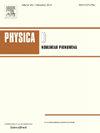化学反应卡森流体通过多孔层的非线性热盐对流中的磁振荡不稳定性:开放边界的影响
IF 2.9
3区 数学
Q1 MATHEMATICS, APPLIED
引用次数: 0
摘要
本文研究了卡森流体通过顶部打开的多孔介质时非线性热盐对流的振荡不稳定性。该问题使用非线性的Oberbeck-Boussinesq近似来描述流体密度如何变化。它还包括在外部施加的垂直磁场下由于粘性耗散而产生的加热,伴随着一级化学反应。通过选择合适的尺度,对流场进行无量纲化处理,同时对基流进行小波动扰动,检验不稳定性理论。采用龙格-库塔法结合射击技术,对稳定性分析中出现的特征值问题进行了数值积分。对各流控参数的临界热瑞利数作了图解,并以表格形式给出了定量值。结果表明,当下边界的溶质浓度高于上边界时,非线性溶质效应γ - 2稳定了两个边界上的溶质分布(RaS<0)。而在零溶质输运条件下(Ras=0), γ - 2是线性的。值得注意的是,稳定的γ - 2已经变得不稳定,因为在上界有大量的溶质相对于在下界(RaS>0)。尽管如此,在每种情况下,非线性热效应γ - 1都会导致不稳定。此外,哈特曼数Ha延缓了对流的开始,减少了亚临界不稳定区域。在负溶质瑞利数下,基本流的倾角稳定了热不稳定性,而横向卷对应于对流开始时最不稳定的模式。较低的卡森参数(β)导致流体表现出非常极端的非牛顿行为,从而阻止振荡活动。较高的化学反应性使流线向上移动,使等温线指向开放边界,并使等盐线集中。强反应性也会削弱横向涡旋,并在边界附近形成对称的等温涡,而等盐线则先上升,然后在多孔层中扩散。本文章由计算机程序翻译,如有差异,请以英文原文为准。
Hydromagnetic oscillatory instability in non-linear thermohaline convection of chemically reactive Casson fluid through a porous layer: Effect of open boundary
This work investigates oscillatory instability in non-linear thermohaline convection of Casson fluid flow through a porous medium open at the top. The problem uses a non-linear Oberbeck–Boussinesq approximation to describe how fluid density changes. It also includes heating due to viscous dissipation under an externally imposed vertical magnetic field, accompanied by a first-order chemical reaction. The flow field is non-dimensionalized with the help of the proper choice of scales, while the base flow is then perturbed with a small fluctuation to examine instability theory. The Runge–Kutta method, combined with the shooting technique, is employed for the numerical integration of eigenvalue problems that arise from stability analyses. The graphical illustration is made for critical thermal Rayleigh numbers concerning each flow-governing parameter, and quantitative values in tabular form are provided. Our results reveal that the non-linear solutal effect acts to stabilize the solute distribution over the two boundaries when the lower boundary has a higher concentration of solute than the upper boundary (). Under zero solute transport conditions (), however, is linear. Of note is the fact that the stabilized has become destabilized because of the large amount of solute at the upper boundary relative to that at the lower (). Still, in every case, the non-linear thermal effect acts to destabilize. Also, the Hartmann number delays the onset of convection and reduces the region of subcritical instabilities. At negative solutal Rayleigh numbers, the obliqueness of the basic flow stabilizes the thermal instability, while transverse rolls correspond to the most unstable mode for the onset of convection. A lower Casson parameter () causes the fluid to exhibit very extreme non-Newtonian behavior, which prevents oscillatory activity. Higher chemical reactivity shifts streamlines upward, directs isotherms towards the open boundary, and centralizes isohalines. Strong reactivity also weakens the transverse rolls and causes symmetrical isotherm vortices near the boundaries, whereas the isohalines begin by rising and then spreading through the porous layer.
求助全文
通过发布文献求助,成功后即可免费获取论文全文。
去求助
来源期刊

Physica D: Nonlinear Phenomena
物理-物理:数学物理
CiteScore
7.30
自引率
7.50%
发文量
213
审稿时长
65 days
期刊介绍:
Physica D (Nonlinear Phenomena) publishes research and review articles reporting on experimental and theoretical works, techniques and ideas that advance the understanding of nonlinear phenomena. Topics encompass wave motion in physical, chemical and biological systems; physical or biological phenomena governed by nonlinear field equations, including hydrodynamics and turbulence; pattern formation and cooperative phenomena; instability, bifurcations, chaos, and space-time disorder; integrable/Hamiltonian systems; asymptotic analysis and, more generally, mathematical methods for nonlinear systems.
 求助内容:
求助内容: 应助结果提醒方式:
应助结果提醒方式:


